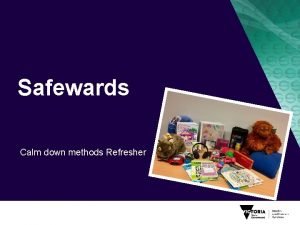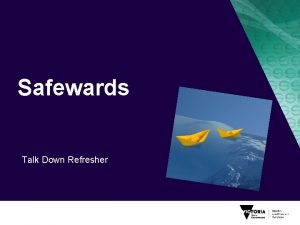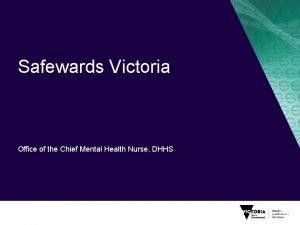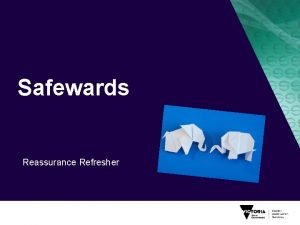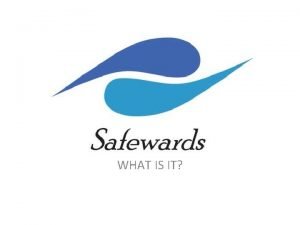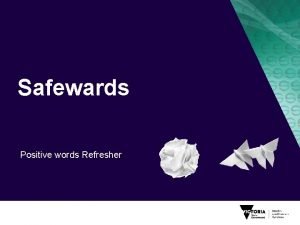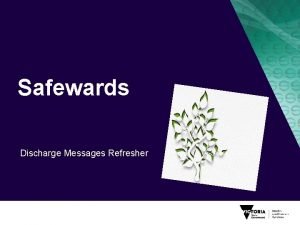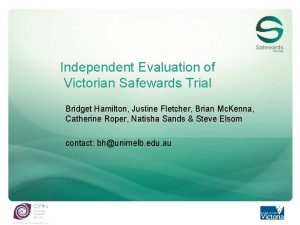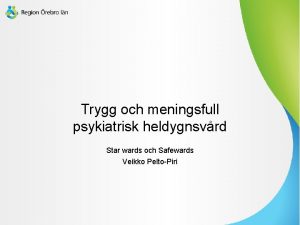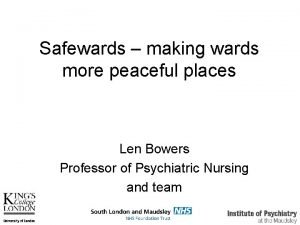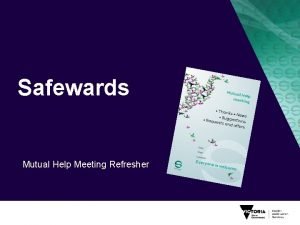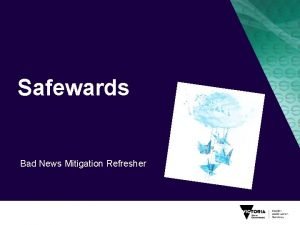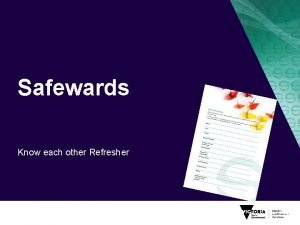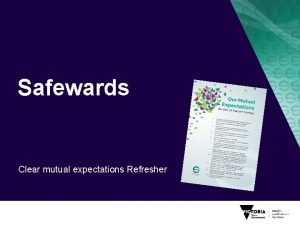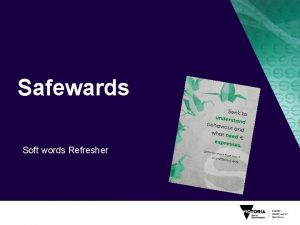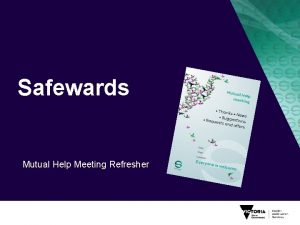Safewards Calm down methods Refresher Explanationinformation Role modelling











- Slides: 11

Safewards Calm down methods Refresher

Explanation/information, Role modelling, Patient education, Removal of means, Presence & presence+ Staff Modifiers Denial of request, Staff demand, Limit setting, Bad news, Ignoring Flashpoints Staff anxiety & frustration, Moral commitments, Psychological understanding, Teamwork & consistency, Technical mastery, Positive appreciation Staff Modifiers A, , IC Rules, Routine, Efficiency, Clean/tidy, Ideology, Custom & practice Internal Structure Staff Team ics s s, ne c ti blo rs g rou tive ifie ckin erna od e, Che dy, Alt ff M isitiv & Ti Sta & inqu, Clean spect t oin de, shp litu Exit Fla ecy, Soshock, r Sec ission ked m Ad CONTAINMENT ork Anxiety management, Mutual support, Moral commitments, Psychological understanding, Technical mastery rist hy , Male, g cte p ed un ara ogra. , Abusall. s, Yo Ch em nhib s, H nt & d y/disi lusion tie Pa ptomsritabiliitght, De , Ir ns Symtraits sion, I s rs , PD re oia s, Dep an Par /drug Alc Patient Modifiers al f E r Ap ame xter pe wo n Re als, Prork, Natal Stru gul io s ato ecutionnal polcture ic s, ry Fra Hospitya, Comp la lp me w olicy ints, & sis ifie od erapy al analyns ff M coth ction entio Sta. Pharmya & fun& interv rap ort the upp cho g s ts Psy ursin N or al E sic t U Re ce ilan enan ices, PIC vig t n, cho gly Main sio nts rin Ca cor, es eclu poi Dé tur ity, S ture Fea plex , Liga om ooms , C t lity ory r en ua s , Q sen nm ked rt/ iro loc omfo nv C Do y Ph Leg Flashpoints Assembly/crowding/activity Queuing/waiting/noise Staff/pt turnover/change Bullying/stealing/ prop. damage oin s; y shp tion ntit Fla rba ide e c ce/ ty Exa nden everi s e ep ity/ Ind Acu CONFLICT C Fla Ad omp shp uls m o Co mp ission ory d ints l a tre int , App eten atm de ti e en nied al ref on, D t, E , En usa Ho ue p S t x pe l a it r f f , roc efu orce , Leg Infor ess, J f M sed d m o u Co itima atio stice dif nsi cy, n g , R ier ste e i nt Comp ving, spec s po licy ensa Supp t for , Fl tor ort righ exi y a bili uto to ap ts, p ty, n Re omy eal, spe , ct ie ctiv mil in e p y th volv rs ati era em en en t su py t pp F o l r Ba a t d n sh Los ew po s o s, H in acc f rela ome ts om tio cri Arg mod nship sis, um atio or en n, t Ou ito tsid De rs, Re pe e. H nd lative en osp cy s & f Str & i am ita e s nst i l itu ly ten sors tio na sions lisa tio , Pros n, De pecti ma ve Sta nd –ve Ca s& rer ff M /re ho move lat od me i F ve if a A Vis Patient Community Patient – patient interaction Contagion & discord

Background aims Background Pro re nata (PRN) medication can been used as an effective strategy to assist people to feel calm, but perhaps we reach for it too easily and too quickly. Where possible and practical, it’s always best to use the patient’s own strengths and coping mechanisms – or support people to develop new strengths and skills – to enable people to self-regulate. Aims • Early de-escalation • Divert and prevent • Increase people’s sense of empowerment and self-control (these processes contribute to recovery)

Calm Down Methods and the Safewards Model Staff modifier: Staff modifiers Calm Down Methods Patient modifiers Originating domains Patient characteristics Flashpoints Conflict Containment

Benefits PRN medication is an effective strategy for some people, some of the time, however calm down methods can: • Support people to draw on their own strengths and coping mechanisms • Offer alternatives to medication, that can be sustained well past an admission • Build self-knowledge • Facilitate learning of new strengths and skills

Early signs of distress/agitation Notice potential changes in: • facial expression • tone of voice • quick response to a normal reminder • restlessness • breathing patterns • body language • eye contact (or lack thereof) • movement around the ward

Task: Calm down methods handout Think about what might be helpful for different types of ‘calm down’ needs. • Difficult emotions • Difficult thoughts and urges • Difficult experiences Think about different types of resources and the functions they could serve. Sensory & grounding, comfort & soothing, humour, distraction, mindfulness, inspirational, expressive & venting, harm minimisation, problem solving & reflection, movement & activity, drawing on nature or creativity ‘It can be easy to say someone is agitated but harder to understand why’

Calm down methods in practice • Assemble a box of ‘calm down resources’ for your unit • Offer/explore calm down methods before considering PRN • Support people to explore the potential uses of calm down methods • Some of the calm down activities can be done together • Record calm down methods use in a log book, and patient files

Role of the intervention lead • Suggest when calm down methods are appropriate • Ask if/how calm down was used when people mention agitation or PRN at handover • Ask if/how calm down was used if there was a restrictive intervention • Ensure resources are easily available to patients when needed • Check resources regularly to ensure items are returned, clean and in good working order (develop an infection control plan) • Replace missing, depleted or broken items Expanding Calm Down Methods… • Look at increasing the number and type of resources over time • Make calm down resources available in more spaces • Think about how patients can take resources home after discharge

Calm down methods fidelity Calm down methods IS NOT • A practical set of equipment and patient resource for self–help when in distress = ≠ • A store of equipment that can be used to help people who may be feeling agitated/restless, anxious/frightened, angry/irritable, ashamed or depressed/despairing to reach a relaxed state of mind • A box of things that gathers dust in the office or gets dragged to a group • A store of equipment for diversional or recreational activities for patients to do on request

Calm down methods adjustments CAMHS Safety and supervision review, choice of items different Forensic Safety and supervision review, choice of items different Older people Safety and supervision review, choice of items different
